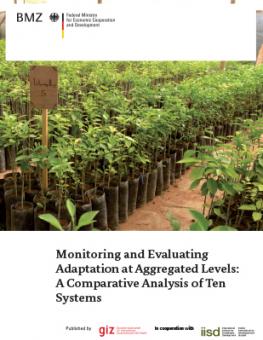
Monitoring and Evaluating Adaptation at Aggregated Levels: A Comparative Analysis of Ten Systems
The paper Monitoring and Evaluating Adaptation at Aggregated Levels: A Comparative Analysis of Ten Systems provides an introduction to different approaches and experiences in designing and implementing (piloting) M&E systems for adaptation at the portfolio, national, regional and international levels.
Drawing upon information gathered through a combination of document analysis and stakeholder interviews, it compares ten aggregate M&E systems according to their context, processes and content.
The analysis provides insights into challenges and enabling factors for the design and implementation of M&E adaptation systems at higher, aggregated levels. Challenges identified include the conceptual ambiguity of what constitutes successful adaptation; coordination and harmonization across sectors, scales and partners; resource and capacity constraints; and identification and access to data and information.
Enabling factors for designing, establishing and, where relevant, implementing M&E systems for adaptation were also identified, namely: political will and leadership; multi-stakeholder participation; and alignment and/or integration of an evolving M&E system for adaptation into/with existing M&E structures, which can save resources in the long run. The report concludes by providing recommendations regarding ways in which to strength the development of aggregated level M&E adaptation systems.
Monitoring and Evaluating Adaptation at Aggregated Levels: A Comparative Analysis of Ten Systems was written by Anne Hammill and Julie Dekens of IISD for Deutsche Gesellschaft für Internationale Zusammenarbeit (GIZ), acting on behalf of Germany’s Federal Ministry for Economic Cooperation and Development (BMZ).
Participating experts
You might also be interested in
Developing national adaptation monitoring and evaluation systems: A guidebook
This guidebook is intended for decision makers and technical advisors involved in the development of national monitoring and evaluation (M&E) systems for adaptation, particularly in developing and middle-income countries.
Border Carbon Adjustments: Trinidad and Tobago country report
This report consolidates, analyzes, and presents views and perspectives of stakeholders from Trinidad and Tobago on border carbon adjustment (BCA) schemes to contribute to the global debate on BCA good practices.
Modelling the Impacts of Policy Interventions for Agrifood Systems Transformation in Indonesia
This report provides context and insights for agrifood systems transformation efforts in Indonesia by detailing an innovative modelling approach and offering policy implications and next steps to inform the Indonesian government's development planning.
How Can We Work With Nature to Tackle Drought and Desertification?
Drought is one of the most devastating and pervasive challenges exacerbated by climate change. However, we can work to reduce its effects through nature-based solutions for land restoration and climate-smart agriculture.